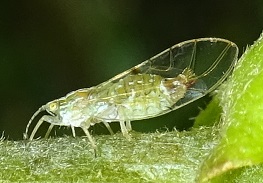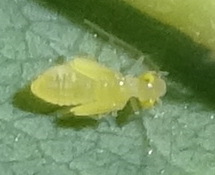| Home | Nature Weekly Index |
1 January 2017 | Jumping Plant Louse | Psyllid | Galls | Fig Trees |
.jpg)
.jpg) While I was researching for the jumping plant louse or a group of tiny insect known as psyllid related to the
Knotweed biological control last week, I thought I
might have found the link between the rambutan-like galls found on the leaves of a species of fig tree here.
Apparently, some people refer to the "fruit-like" structures on fig trees as galls and the flowers in the galls
as gall-flower. I would prefer to call it fig to avoid confusion with the galls found on its leaves.
While I was researching for the jumping plant louse or a group of tiny insect known as psyllid related to the
Knotweed biological control last week, I thought I
might have found the link between the rambutan-like galls found on the leaves of a species of fig tree here.
Apparently, some people refer to the "fruit-like" structures on fig trees as galls and the flowers in the galls
as gall-flower. I would prefer to call it fig to avoid confusion with the galls found on its leaves.
A post in June 2007 by the Urban Forest blog shared a picture of these galls on a leaf found at Bukit Timah Nature Reserve but the name of the host plant was not mentioned. It described the galls as “mini rambutan”. This was probably the earliest picture that I could locate on this hairy gall. Another picture was posted by the Lazy Botanist blog in January 2015, located at MacRitchie. There was no mentioned of the host plant as well. The most extensive set of picture was posted by Yi Shuen in her Flickr site. The gall photos with the immature insect in the galls were taken in August 2013 while the mature insect was photographed in September 2014. The host plant was identified as Ficus variegata (Common Red-stem Fig).
.jpg)
.jpg) As for me, my first picture on the gall was taken in 2009 on the leaf of a Ficus variegata at Admiralty
Park. Subsequently, I wrote a short note on these galls in 2011, which
I had updated today. At that time, I had already suspected the relationship between the tiny orange winged insect
found on the leaves of the fig tree and the galls on the leaves except that I had no clue on the on the type of
insect until last week. Originally, I thought it might be a kind of bee or wasp. Now, I was quite certain that
it was a jumping plant louse (or psyllid). There seemed to be little interest in this gall over the years
judging from the information available despite its unique appearance and specificity to this fig tree.
As for me, my first picture on the gall was taken in 2009 on the leaf of a Ficus variegata at Admiralty
Park. Subsequently, I wrote a short note on these galls in 2011, which
I had updated today. At that time, I had already suspected the relationship between the tiny orange winged insect
found on the leaves of the fig tree and the galls on the leaves except that I had no clue on the on the type of
insect until last week. Originally, I thought it might be a kind of bee or wasp. Now, I was quite certain that
it was a jumping plant louse (or psyllid). There seemed to be little interest in this gall over the years
judging from the information available despite its unique appearance and specificity to this fig tree.
 With the renew interest in the rambutan galls, I made a trip to Admiralty Park last Saturday to check out the
jumping plant louse. Surprisingly, not a single infected leaf could be found. The appearance of the galls may be
seasonal. Nevertheless, I did find a tiny insect on a
Sea Hibiscus (Talipariti tiliaceum) which resembled a
jumping plant louse. Its length was closed to that of
Cocoa Black Ant (Dolichoderus thoracicus)
which could be seen roaming on the same plant.
With the renew interest in the rambutan galls, I made a trip to Admiralty Park last Saturday to check out the
jumping plant louse. Surprisingly, not a single infected leaf could be found. The appearance of the galls may be
seasonal. Nevertheless, I did find a tiny insect on a
Sea Hibiscus (Talipariti tiliaceum) which resembled a
jumping plant louse. Its length was closed to that of
Cocoa Black Ant (Dolichoderus thoracicus)
which could be seen roaming on the same plant.
 Another reason for the trip was to try to find the agent that caused the galls on the leaves of the
Litsea elliptica. The infection was a common sight on the
leaves of this plant. After staring hard on the surfaces of many infected leaves, not a single suspect was found.
A lone suspect was spotted under one of the leaves but on further close-up examination, it was more likely to be
the nymph of a
katydid (Asiophlugis temasek)
judging from the colour of its eyes and the length of its antennae. Based on my previous sightings, this katydid
was a resident of this park.
Another reason for the trip was to try to find the agent that caused the galls on the leaves of the
Litsea elliptica. The infection was a common sight on the
leaves of this plant. After staring hard on the surfaces of many infected leaves, not a single suspect was found.
A lone suspect was spotted under one of the leaves but on further close-up examination, it was more likely to be
the nymph of a
katydid (Asiophlugis temasek)
judging from the colour of its eyes and the length of its antennae. Based on my previous sightings, this katydid
was a resident of this park.
Hopefully, I will be able to figure out the causative agent of the galls on the Litsea elliptica leaves in the near future.
Update: 6 October 2022
The jumping plant louse seen on the Common Red-stem Fig should be Pauropsylla udei.
Update: 22 May 2025
The jumping plant louse seen on the Sea Hibiscus should be Mesohomotoma hibisci.